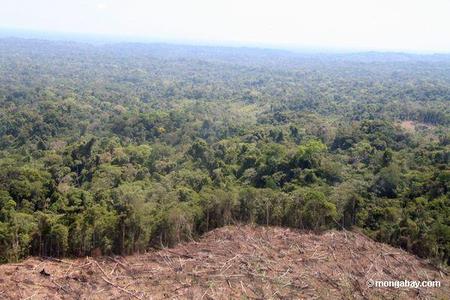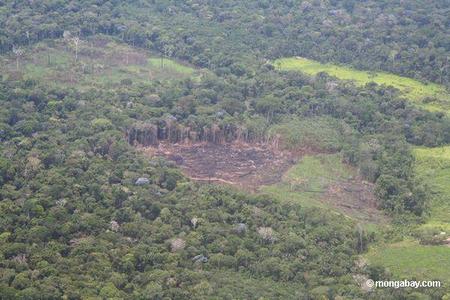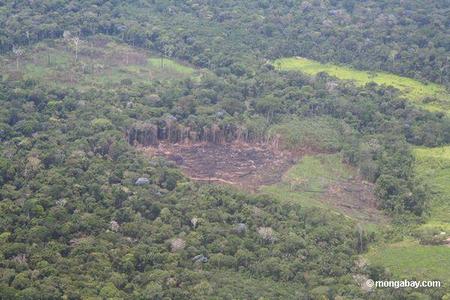As I flew over the Peruvian rainforest, I kept a lookout for flames. I’d heard that, despite international outrage over the loss of millions of acres of trees, the Amazon basin was still going up in smoke. Now I’d come to see for myself, and it didn’t take long. Out the window of the small LAN-Peru jet I was taking from Cuzco to Puerto Maldonado, a bustling frontier town perched on a tributary of the Amazon, I saw a tall grey column billowing up from the ground 19,000 feet below.

Oscar, my guide for the next four days, confirmed that that was the case. As we boarded a long, narrow motor boat for our five-hour trip into the wilds that host the Heath River Wildlife Center, the rainforest specialist noted that fires and clearcuts remain the biggest threat facing the region known for serving as the “globe’s lungs.”

Oscar acknowledged that logging is a major problem. But, he said, agriculture also figures substantially into the destruction equation. “Raising cattle and growing soybeans leave a big scar on the land,” he said. “You want prestige in the Amazon, you clear the forest, grow crops, and make money. It’s as simple as that.”
Independent research from various scientists as well as groups like Mongo Bay , the Nature Conservancy, and Greenpeace verify that raising cattle, growing soybeans and logging are the most damaging forces behind rainforest destruction. Though most studies have focused on Brazil, Peru isn’t immune to the same marketplace forces. While many fastfood restaurants in the U.S. have pledged not to use beef or soy products grown on recently deforested tracts of land, the Asian and European markets haven’t been so responsible. And consumers everywhere continue to buy tropical woods because they are beautiful, unusual, and resistant to rot.
The impact of consumer demand is making itself felt in Peru. As MongoBay.com points out, about half of this medium-sized country is forested. Of this, more than 80 percent is classified as primary forest. In other words, it’s never been cut. Nevertheless, the international Food and Agriculture Organization estimates that the country loses somewhere between 224,000 and 300,000 hectares of forest per year.
Notes Mongo Bay: “Currently most logging in Peru is illegal. One scientist at the Research Institute of the Peruvian Amazon estimates that 95 percent of the mahogany logged in the country is harvested illegally. Because the wood is so valuable, traffickers are known to cut trees inside national parks and reserves. They also have little to fear: as of early 2006, not a single commercial logger had been imprisoned in Peru for illegal logging.”
A further source of deforestation and environmental degradation in the Peruvian Amazon, says MongoBay.com, is gold mining. “Peru’s forests are home to alluvial gold deposits that are pursued by large-scale operators and informal, small-scale miners. Both kinds of operators rely heavily on hydraulic mining techniques, blasting away at river banks, clearing floodplain forests, and using heavy machinery to expose potential gold-yielding gravel deposits.
“Mercury contamination and increased river sedimentation can be a problem downstream from operations, while mining roads can open remote forest areas to transient settlers and land speculators. Further, shantytowns that spring up in areas believed to hold gold deposits increase pressure on forests for building material, bushmeat, fuelwood, and agricultural land.”
Indeed, during the first two hours of our boat trip, we saw at least a dozen prospectors industrially sifting gravel in their search for gold. Eventually, they would use mercury to bind small gold chunks into bigger nuggets, and think nothing of washing all the residue into the same river water that serves as their kids’ swimming hole — as well as the water source for Peru’s 2,937 known species of amphibians, birds, mammals, and reptiles, according to figures from the World Conservation Monitoring Centre. Of these, 16.0 percent are endemic, meaning they exist in no other country, and 7.6 percent are threatened. In addition, Peru is home to at least 17,144 species of vascular plants, of which 31.2 percent are endemic.
Scott Paul, the Director of Forest Campaigns for Greenpeace USA, says the marketplace can play a critical role in helping to curb rainforest destruction. Already, McDonald’s in the U.S. and Europe has pledged not to use products – including beef and soy-based feed for chickens – produced in newly cleared rainforests as a way to discourage further forest destruction. Home Depot minimizes the amount of wood it buys from rainforests and sources as much wood as possible from producers that meet the sustainable forestry criteria established by the Forest Stewardship Council.
Paul credits consumer pressure as well as high-profile publicity campaigns like those Greenpeace wages for these successes.
“I’ve seen individual consumer actions change government and corporate policies,” he says. The way people spend their money can be “insanely effective” in persuading companies to safe the rainforest rather than destroy it.
Paul says here in the U.S., consumers can take two key steps to protect the Amazonian basin.
* Buy locally produced food. Read labels and look for products made in America. Choose locally-raised beef and chickens, an increasing feature at farmer’s markets, food co-ops and natural-food grocery stores. Avoid canned meat. Apart from the fact that a “food” like this sounds unappealing to begin with, it is also one way that Latin American producers are sneaking their goods into the marketplace. Most tofu and other soy-based foods are made from soybeans grown in the U.S., so for the moment, anyway, Paul says that purchasing those goods won’t impact the rainforest either way.

Oscar, my Peruvian guide, would add:
* Support sustainable tourism. “Owning and running an eco-lodge is fast approaching cattle ranching and farming as a prestige occupation in Peru,” he says. “And it’s far better for the forest because protecting the forest ecosystem is key if lodge owners and their employees are going to make any money.”















3 thoughts on “The Amazon is Still Burning – Are you buying tropical wood?”
Fantastic post! That must have been a real eye-opener to actually SEE the burning. Too bad more of us aren’t seeing it, we might actually be compelled to DO something.
Thanks. Yes, it was unbelievable – and so disheartening. We hear so little about the rainforest anymore, yet it’s still going up in smoke. I hope the next Prez (ie, Obama) will put saving the rainforest back on the national agenda.
Wow, striking images. Good job on bringing these pictures to the consciousness of more people. We need to understand what is going on, and how unnecessary it is. There are sustainable forestry methods that can be used. The FSC certification is a powerful tool in consumer awareness. Many lumber companies are embracing it. Here is one example of such a business. We need to start supporting those that are taking concrete and positive steps forward. Look up your local FSC-certified wood supplier next time you go to build!
Comments are closed.